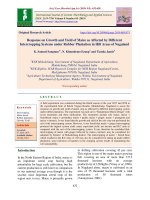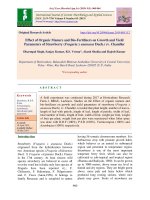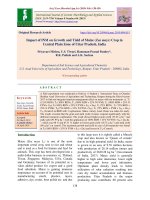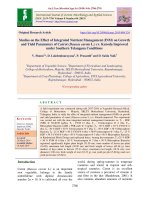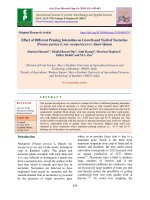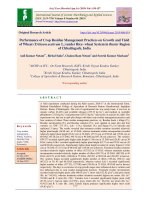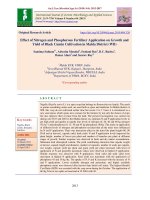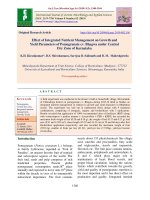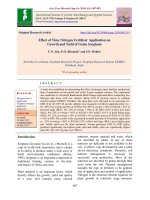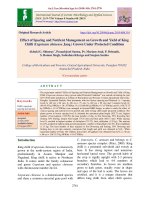Performance of crop residue management practices on growth and yield of wheat (Triticum aestivum L.) under rice- wheat system in Bastar region of Chhattisgarh, India
Bạn đang xem bản rút gọn của tài liệu. Xem và tải ngay bản đầy đủ của tài liệu tại đây (408.71 KB, 8 trang )
Int.J.Curr.Microbiol.App.Sci (2019) 8(6): 150-157
International Journal of Current Microbiology and Applied Sciences
ISSN: 2319-7706 Volume 8 Number 06 (2019)
Journal homepage:
Original Research Article
/>
Performance of Crop Residue Management Practices on Growth and Yield
of Wheat (Triticum aestivum L.) under Rice- wheat System in Bastar Region
of Chhattisgarh, India
Anil Kumar Netam1*, Birbal Sahu2, Chainu Ram Netam3 and Suresh Kumar Markam2
1
AICRP on IFS – On Farm Research, IGKV, Krishi Vigyan Kendra, Kanker,
Chhattisgarh, India
2
Krishi Vigyan Kendra, Kanker, Chhattisgarh, India
3
College of Agriculture & Research Station, Bemetara, Chhattisgarh, India
*Corresponding author
ABSTRACT
Keywords
Crop residue
management,
Wheat, Varieties,
Growth, Crop
stages, Yield,
Economics
Article Info
Accepted:
04 May 2019
Available Online:
10 June 2019
A field experiment conducted during the Rabi season, 2016-17 at the Instructional Farm,
Shaheed Gundadhoor College of Agriculture & Research Station, Kumhrawand, Jagdalpur
District- Bastar (Chhattisgarh). The soil of experimental site was sandy loam; it was low in
organic carbon (0.44%) and available nitrogen (235.15 kg ha -1) and medium in available
phosphorus (13.10 kg ha-1) and potassium (291.33 kg ha-1) and acidic in reaction (6.2 pH). The
experiment was laid out in spilt plot design with three crop residue management practices and
four varieties of wheat. Three residue management practices viz. Residue burnt + tillage (T1),
Residue incorporation (T2) and Residue retention (T3), were applied in main plot and four
varieties viz. GW- 273 (V1), Lok- 1 (V2), Kanchan (V3) and Sujata (V4) in sub-plot and
replicated 3 times. The results revealed that treatment residue retention recorded relatively
higher plant height (16.90 cm) at 15 DAS, whereas treatment residue incorporation recorded
relatively higher plant height (26.42 cm) at 30 DAS, (57.51 cm) at 45 DAS and (75.09 cm) at
60 DAS, (93.28 cm) at 75 DAS, (96.74 cm) at 90 DAS and (97.28 cm) at harvest. The varieties
GW-273 recorded significantly higher plant height (17.66 cm) at 15 DAS and (26.81 cm) at 30
DAS, variety LOk-1 recorded significantly higher plant height (62.77 cm and 78.24 cm) at (45
and 60 DAS) respectively. Significantly higher plant height recorded of variety Sujata (113.04
cm) at 75 DAS, (113.51 cm) at 90 DAS and (114.06 cm) at harvest. Treatment residue retention
recorded relatively higher number of tillers (427.92) at 15 DAS, whereas treatment residue
incorporation recorded relatively higher number of tillers (693.75) at 30 DAS, (862.50) at 45
DAS, (618.75) at 60 DAS, (549.08) at 75 DAS, (545.67) at 90 DAS and (544.92) at harvest.
The varieties Sujata recorded significantly higher number of tillers (749.44), (901.11) and
(652.22) at 30, 45 and 60 DAS respectively, whereas variety Lok-1 recorded significantly
higher number of tillers (577.22), (577.00) and (576.44) at 75 DAS, 90 DAS and at harvest
respectively. The days to occurrence of crop growth stages more influenced due to varieties and
less influenced due to crop residue management practices. Treatment residue incorporation
recorded relatively higher grain yield (40.63 q ha -1), straw yield (32.92 q ha-1) and gross return
(Rs. ha-1 64,541), whereas treatment residue retention recorded highest net return. (Rs. ha -1
39,308) and B: C ratio (Rs. 2.81). Varieties Lok-1 recorded significantly higher grain yield
(43.36 q ha-1), harvest index (61.35%), gross return (Rs. ha -1 66,130), net return (Rs. ha-1
41,452) and B: C ratio (Rs. 2.68). Variety Sujata produces significantly higher straw yield
150
(34.83 q ha-1).
Int.J.Curr.Microbiol.App.Sci (2019) 8(6): 150-157
natural resources not a waste. Residue
management is receiving a great deal of
attention because of its diverse effects on soil
physical, chemical and biological properties
(Kumar and Goh, 1999).
Introduction
Rice (Oryza sativa L.) - Wheat (Triticum
aestivum L.) cropping system is a the most
predominant
production
and
nutrient
exhaustive system occupying about 18 M ha
in Asia, of which 13.5 M ha area in IndoGangetic Plains of India, Pakistan (2.2 M ha),
Bangladesh (0.8 M ha) and Nepal (0.5 M ha)
and feeds about 1.3 billion people (20% of the
world population) (Farooq et al., 2007,
Saharawat et al., 2010). Wheat occupies an
area of 0.18 million hectares with the
production of 0.28 million tones and average
productivity of 1550 kg ha-1 during 2017-18
(Anonymous, 2018) in the state and most of
the area under rice- wheat system. Farmers
normally use wheat straw as animal feed but
rice straw is either burnt or used as animal
feed and fuel source in rural area or
incorporation in the field. Residue
retention/incorporation into soil is an essential
management practice to handle crop residue.
The retention/incorporation of rice residues
may affect soil fertility, soil physico chemical properties and yield of the crop.
Information on the kinetics of decomposition
of the crop residues and mineralization,
immobilization turnover of different quality
crop residues is required to ascertain the
actual amount of crop residues needed to
maintain the soil productivity and ensure
environment protection by minimizing
nutrient losses and soil erosion. Addition of
soil organic matter to the soil through the
return of crop residues, also improve soil
structure, influences soil water, air and
temperature relations, help control runoff and
erosion and makes tillage easier. Crop residue
is a good source of plant nutrients and
important component for the stability of the
agricultural ecosystem. About 25% of N and
P, 50% S and 75% of K uptake by cereal
crops are retained in crop residue, making
them viable nutrient sources (Dotaniya,
2013). Crop residue and their proper
management affect the soil quality either
directly or indirectly. Intensive cropping
system is very diverse and complex, so no one
residue management system is superior under
all
situations.
Ideally crop
residue
management practices should be selected to
enhance crop yields with a minimum adverse
effect on environment. It is suggested that in
each cropping system the constraints to
production
and
sustainability
should
identified and conceptualized to guide
towards the best option. There is a need to
identify and recommend a more productive,
profitable and environmentally sound crop
residue management system. Objective of this
study was to examine the effects of the three
crop residue management practices on growth
and yield of wheat under rice- wheat cropping
system.
Nutrients in crop residues and soil
amendments are more available to crops if
they are retained/incorporated into the soil
rather than burnt, burning of crop residue
destroys our precious natural resource (the
organic matter) that may adversely affect soil
physical, chemical and biological properties
(Gangwar et al., 2006). The imbalance use of
chemical fertilizers in the last four to five
decades has led to the paralleled
corresponding decline in the use of cover
crops and organic manures. Conventional
management practices have led in the decline
in soil organic matter, increased soil erosion,
and surface and ground water contamination.
Until recently, we fail to recognize the
consequences of management on the balance
and cycling of energy and dry matter and soil
productivity. Crop residues are tremendous
151
Int.J.Curr.Microbiol.App.Sci (2019) 8(6): 150-157
dividing the grain yield with biological yield
(grain + straw yield) and multiplied by 100.
Materials and Methods
A field experiment was conducted during the
Rabi season of 2016-17, at the Instructional
Farm, Shaheed Gundadhoor College of
Agriculture
&
Research
Station,
Kumhrawand, Jagdalpur District- Bastar
(Chhattisgarh). The soil of experimental site
was sandy loam; it was low in organic carbon
(0.44%) and available nitrogen (235.15 kg ha1
) and medium in available phosphorus (13.10
kg ha-1) and potassium (291.33 kg ha-1) and
acidic in reaction (6.2 pH).The experiment
was laid out in spilt plot design with three
crop residue management practices and four
varieties of wheat. Three residue management
practices viz. Residue burnt + tillage (T1),
Residue incorporation (T2) and Residue
retention (T3), were applied in main plot and
four varieties viz. GW- 273 (V1), Lok- 1 (V2),
Kanchan (V3) and Sujata (V4) in sub-plot and
replicated 3 times. Recommended dose of
nutrients was 100:60:40 kg N: P: K ha-1.
Entire quantity of phosphorus & potassium
was applied before sowing. Nitrogen applied
in three splits i.e. 50% as a basal, 25% at
tillering and 25% at panicle emergence stage.
Experiment was conducted under irrigated
condition and irrigated 5 times in different
crop stages. Crop seed sown on 30th
November, 2016 with a row spacing of 20 cm.
Herbicide pendimethalin 30 EC applied @
0.75 kg ha-1 in 3rd day. The average
maximum and minimum temperature varied
between 27.80c-33.70c and 15.20c-26.00c
respectively.
Harvest
Index
(%)
Grain
Biological
yield
(q/ha)
yield
X100
(q/ha)
Results and Discussion
Plant height
Average plant height increased progressively
with increase in the age of the crop. The plant
gained height at relatively slower rate
between 75 to 90 DAS and accelerated
between 15 to 75 DAS. The Plant height of
wheat varieties influenced significantly,
whereas plant height of wheat did not
influenced due to crop residue management
practices (Table 1). Among the residue
management practices treatment residue
retention recorded relatively higher plant
height (16.90 cm) at 15 DAS, while treatment
residue incorporation recorded relatively
higher plant height (26.42 cm) at 30 DAS,
(57.51 cm) at 45 DAS, (75.09 cm) at 60 DAS,
(93.28 cm) at 75 DAS, (96.74 cm) at 90 DAS
and (97.28 cm) at harvest, followed by
treatment residue burnt along with tillage
(93.01 cm) at 75 DAS, (94.02 cm) at 90 DAS
and (94.81 cm) at harvest.
Among the varieties GW-273 recorded
significantly higher plant height (17.66 cm)
followed by Sujata (16.28 cm) at 15 DAS.
Variety GW- 273 recorded significantly
higher plant height (26.81 cm), followed by
Lok-1 (26.39 cm) at 30 DAS, variety LOk-1
recorded significantly higher plant height
(62.77 cm & 78.24 cm) followed by Sujata
(56.01 cm & 75.70) at (45 and 60 DAS)
respectively. Significantly higher plant height
recorded of variety Sujata at 75 DAS (113.04
cm), 90 DAS (113.51 cm) and at harvest
(114.06 cm) followed by Kanchan 88.50 cm,
90.18 cm, 90.87 cm at 75 DAS, 90 DAS and
at harvest respectively. In case of varieties
The plant height was measured randomly of 5
plants of each plot in centimeter from ground
surface up to the tip of awn. The number of
tillers counted from 0.25 m2 area by placing a
quadrate of 0.5 m x 0.5 m randomly at 4
places in each plot and then number of tillers
m-2 worked out. Occurrence of crop stages
recorded by visited every day at experimental
site. The harvest index was calculated by
152
Int.J.Curr.Microbiol.App.Sci (2019) 8(6): 150-157
difference in plant height may be due to their
genetic characters.
influenced due to residue management
practices. All the varieties start germination in
5 day. Variety Sujata taken more time for 1st
true leaf stage (8.67 day), 3 leaf stage (16.33
day), CRI (22.33 day), panicle emergence
(67.33 day), 50% flowering (71.33 day),
milking (85 day) and maturity (113 day)
followed by Kanchan for 1st true leaf stage
(8.33 day), 3 leaf stage (16.33 day), panicle
emergence (60.67 day), 50% flowering (65.67
day), milking (82 day) and maturity (105 day)
Number of tillers m-2
The number of tillers m-2 increased with
increasing the crop age up to 90 DAS, but the
number of tillers at maturity slightly reduced.
The number of tillers of wheat varieties
influenced significantly, whereas number of
tillers did not influenced due to residue
management practices (Table 2). Among the
residue management practices treatment
residue retention recorded relatively higher
number of tillers (427.92) at 15 DAS, while
treatment residue incorporation recorded
relatively higher number of tillers (693.75) at
30 DAS, (862.50) at 45 DAS, (618.75) at 60
DAS, (549.08) at 75 DAS, (545.67) at 90
DAS and (544.92) at harvest. Similarly in
Dera Ismail Khan (Pakistan) Usman et al.,
(2014), recorded that rice straw incorporation
by tillage resulted the higher number of tillers
m-2.
Grain and straw yield and harvest index
The grain and straw yield and harvest index
significantly influenced due varieties, whereas
grain and straw yield and harvest index did
not influenced due to residue management
practices (Table 3). Among the residue
management practices treatment Residue
incorporation recorded relatively higher grain
yield (40.63 q ha-1) and straw yield (32.92 q
ha-1) followed by treatment Residue burnt
along with tillage recorded grain yield (39.96
q ha-1) and straw yield (29.81 q ha-1), whereas
treatment residue retention recorded relatively
higher harvest index (57.54%) followed by
treatment residue burnt along with tillage
(56.93%). In Pantnagar, Dotaniya (2013)
recorded that rice crop residue incorporation
resulted the highest wheat yield (6.35 q ha-1).
Similarly in Dera Ismail Khan (Pakistan),
Usman et al., (2014) recorded that rice straw
incorporation by tillage resulted the highest
wheat yield (46.70 q ha-1). Higher grain and
straw yield of wheat with treatment Residue
incorporation was mainly attributed with
higher growth parameters like plant height
and number of tillers.
Number of tillers of wheat varieties
influenced significantly at all the stages of
crop growth except 15 DAS. Among the
varieties Sujata recorded significantly higher
number of tillers (749.44), (901.11) and
(652.22) followed by Lok-1 (685.56),
(762.78) and (642.22) at 30 DAS, 45 DAS
and 60 DAS respectively, whereas lowest
number of tillers recorded with GW-273 at
above DAS. Variety Lok-1 recorded
significantly higher number of tillers
(577.22), (577.00) and (576.44) followed by
Kankchan (552.11), (550.56) and (549.78) at
75 DAS, 90 DAS and at harvest respectively,
whereas lowest number of tillers recorded
with GW-273 at above DAS.
Among the varieties Lok-1 produces
significantly higher grain yield (43.36 q ha-1)
followed by Kanchan (41.56 q ha-1), GW-273
(40.66 q ha-1), and Sujata (33.07 q ha-1).
Variety Sujata produces significantly higher
straw yield (34.83 q ha-1) followed by
Days to occurrence of crop growth stages
The days to occurrence of crop growth stages
more influenced due to varieties and less
153
Int.J.Curr.Microbiol.App.Sci (2019) 8(6): 150-157
Kanchan (30.28 q ha-1), GW-273 (30.11 q
ha-1) and Lok-1 (27.36 q ha-1). Harvest index
significantly higher under variety Lok-1
(61.35%) followed by Kanchan (58.74%),
GW-273(58.19%) and Sujata (48.88%).
Higher grain and straw yield of wheat variety
Lok-1 was mainly attributed with higher
number of tillers at reproductive stage and
lower plant height (Table 4; Fig. 1 and 2).
Table.1 Plant height of wheat varieties as influenced by crop residue management practices
Treatment
15 DAS
Crop residue management practices
15.36
Residue Burnt +
tillage
16.44
Residue incorporation
16.90
Residue retention
SEm+
1.34
CD (P = 0.05)
NS
Varieties
17.66
GW-273
15.50
Lok-1
15.49
Kanchan
16.28
Sujata
SEm+
0.51
CD (P = 0.05)
1.52
30 DAS
Plant height (cm)
45 DAS
60 DAS
75 DAS
90 DAS
At
harvest
26.01
55.73
73.41
93.01
94.02
94.81
26.42
25.43
1.56
NS
57.51
57.35
3.29
NS
75.09
73.61
1.50
NS
93.28
91.93
2.72
NS
96.74
93.49
1.48
NS
97.28
93.95
1.40
NS
26.81
26.39
26.38
24.24
0.61
1.80
53.53
62.77
55.14
56.01
1.10
3.27
69.92
78.24
72.28
75.70
1.25
3.72
86.68
82.75
88.50
113.04
1.74
5.16
89.58
85.72
90.18
113.51
1.57
4.66
90.03
86.41
90.87
114.06
1.64
4.87
DAS- Days after sowing
Table.2 Number tillers of wheat varieties as influenced by crop residue management practices
30 DAS
Number of tillers (m-2)
45 DAS 60 DAS
75 DAS
90 DAS
At
harvest
652.08
816.67
597.08
532.08
521.25
520.83
693.75
677.50
65.31
NS
862.50
645.83
43.78
NS
618.75
576.67
53.01
NS
549.08
509.58
23.73
NS
545.67
516.17
24.57
NS
544.92
514.33
24.45
NS
597.78
685.56
665.00
749.44
27.63
82.10
701.11
762.78
735.00
901.11
20.06
59.59
515.00
642.22
607.22
652.22
28.63
85.06
480.00
577.22
552.11
511.67
22.47
66.77
476.67
577.00
550.56
506.56
24.56
72.97
475.89
576.44
549.78
504.67
25.29
75.14
Treatment
15 DAS
Crop residue management practices
397.92
Residue Burnt +
tillage
396.25
Residue incorporation
427.92
Residue retention
SEm+
25.82
CD (P = 0.05)
NS
Varieties
413.33
GW-273
378.89
Lok-1
417.78
Kanchan
419.44
Sujata
SEm+
18.40
CD (P = 0.05)
NS
154
Int.J.Curr.Microbiol.App.Sci (2019) 8(6): 150-157
Table.3 Occurrence of crop stages of wheat varieties as influenced by crop residue management
practices
Treatment
Germi
nation
Crop residue management practices
5.0
Residue Burnt + tillage
5.0
Residue incorporation
5.0
Residue retention
Varieties
5.0
GW-273
5.0
Lok-1
5.0
Kanchan
5.0
Sujata
Occurrence of crop stage (Day)
CRI
Panicle
50%
emergence
Flowering
1st true
leaf
3 leaf
8.0
8.25
8.50
16.50
15.75
16.0
21.25
21.25
21.50
60.50
62.00
60.50
8.0
8.0
8.33
8.67
15.67
16.0
16.33
16.33
22.33
20.0
21.0
22.0
58.67
57.33
60.67
67.33
Milking
Maturity
65.00
65.75
64.25
80.50
81.00
80.50
107.0
107.0
107.0
62.00
61.00
65.67
71.33
78.33
77.33
82.00
85.00
105.0
104.0
105.0
113.0
Table.4 Yield parameters of wheat varieties as influenced by crop residue management practices
Treatment
Grain yield (q ha-1)
Crop residue management practices
39.96
Residue Burnt + tillage
40.63
Residue incorporation
38.40
Residue retention
SEm+
2.40
CD (P = 0.05)
NS
Varieties
40.66
GW-273
43.36
Lok-1
41.56
Kanchan
33.07
Sujata
SEm+
2.34
CD (P = 0.05)
6.96
Straw yield (q ha-1)
Harvest index (%)
29.81
32.92
29.16
1.45
NS
56.93
55.90
57.54
1.93
NS
30.11
27.36
30.28
34.83
2.27
6.76
58.19
61.35
58.74
48.88
2.13
6.32
Table.5 Economics of wheat production as influenced by crop residue management practices
Treatment
Cost of cultivation
(Rs. ha-1)
Crop residue management practices
26505.00
Residue Burnt + tillage
26265.00
Residue incorporation
21715.00
Residue retention
Varieties
24678.00
GW-273
24678.00
Lok-1
24678.00
Kanchan
25278.00
Sujata
Gross return
(Rs. ha-1)
Net return
(Rs. ha-1)
B: C ratio
63345.00
64541.00
61023.00
36840.00
38276.00
39308.00
2.39
2.46
2.81
62012.00
66130.00
63386.00
60349.00
37334.00
41452.00
38708.00
35071.00
2.51
2.68
2.57
2.39
Seed price: Rs. 2600 &3200 q-1 (Sujata), Grain sale price: Rs. 1525 & 1825 q-1 (Sujata)
155
Int.J.Curr.Microbiol.App.Sci (2019) 8(6): 150-157
Fig.1 Occurrence of crop growth stages of wheat varieties as influenced by crop residue
management practices
Fig.2 Weekly meteorological data prevailing during crop growth period (Rabi, 2016-17)
tillage (Rs. ha-1 63,345), whereas treatment
residue retention recorded highest net return.
(Rs. ha-1 39,308) and B: C ratio (Rs. 2.81)
followed by residue incorporation net return.
(Rs. ha-1 38,276) and B: C ratio (Rs. 2.46).
Higher net return and B: C ratio was due
lowest cost of cultivation. Among the
varieties, Lok-1 recorded highest gross return
(Rs. ha-1 66,130), net return (Rs. ha-1 41,452)
and B: C ratio (Rs. 2.68) followed by
Economics of wheat production
Effect of different treatments cannot be
assessed without the gross and net return from
that treatment. The economics of different
treatments have been presented in Table 5.
Among the crop residue management
practices treatment residue incorporation
recorded the highest gross return (Rs. ha-1
64,541) followed by residue burnt along with
156
Int.J.Curr.Microbiol.App.Sci (2019) 8(6): 150-157
Kanchan with gross return (Rs. ha-1 63,386),
net return (Rs. ha-1 38,708) and B: C ratio
(Rs. 2.57). In Varanasi, Rakesh et al., (2019)
recorded that rice crop residue retention
practices resulted higher net return of wheat
(Rs. ha-1 20,619) in 2006 and (Rs. ha-1 30,
854) in 2007.
K. Kumar and K.M. Goh. 1999. Crop residue
and management practices: Effects on
soil quality, soil nitrogen dynamics,
crop yield and nitrogen recovery.
Advances in Agronomy 68: 197-319.
Khalid Usman, Ejaz Ahmad Khan,
Niamatullah Khan, Abdur Rashid,
Fazal Yazdan and Saleem ud Din.
2014. Response of wheat to tillage
plus rice residue and nitrogen
management in rice-wheat system.
Journal of Integrative Agriculture
Doi: 10.1016/S2095-3119(13)607285.
M. L. Dotaniya. 2013. Impact of crop residue
management practices on yield and
nutrient uptake in rice-wheat system.
Current Advances in agricultural
Sciences 5(2): 269-271.
Rakesh Kumar, U.P. Singh and Gaurav
Mahajan. 2019. Performance of Zerotill Wheat (Triticum aestivum L.) and
Weed Species as Influenced by
Residue and Weed Management
Techniques in Rice based Cropping
System. Int.J.Curr.Microbiol.App.Sci.
8(04): 270-277.
Saharawat Yashpal, Singh Bhagat, Malik,
R.K., and Ladha, J.K. 2010.
Evaluation of alternative tillage and
crop establishment methods in a ricewheat rotation in North Western IGP.
Field Crop Research 116: 260-267.
On the basis of experimental findings, it is
concluded that wheat should be sown under
crop residue incorporation for obtaining
higher grain and straw yield and gross return,
whereas wheat should be sown under crop
residue retention for obtaining higher net
return under rice-wheat cropping system.
Wheat varieties Lok- 1 and Kanchan should
be sown for obtaining higher grain yield,
gross and net return in the region.
References
Anonymous. 2018. Directorate of Agriculture.
Government of Chhattisgarh, Raipur.
Farooq U., Sharif M. and Erenstein O. 2007.
Adoption and impacts of zero tillage
in the rice-wheat zone of irrigated
Punjab, Pakistan. Research report.
New Delhi: CIMMYT & RWC.
Gangwar K. S., Singh K. K., Sharma S. K.
and Tomar O. K. 2006 Alternative
tillage and crop residue management
in wheat after rice in sandy loam of
Indo-Gangetic plains. Soil and Tillage
Research, 88: 242-252.
How to cite this article:
Anil Kumar Netam, Birbal Sahu, Chainu Ram Netam and Suresh Kumar Markam. 2019.
Performance of Crop Residue Management Practices on Growth and Yield of Wheat (Triticum
aestivum L.) under Rice- wheat System in Bastar Region of Chhattisgarh, India.
Int.J.Curr.Microbiol.App.Sci. 8(06): 150-157. doi: />
157
